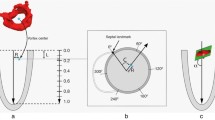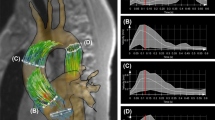Abstract
The flow in the aorta forms a vortex, which is a critical determinant of the flow dynamics in the aorta. Arteriosclerosis can alter the blood flow pattern of the aorta and cause characteristic alterations of the vortex. However, this change in aortic vortex has not yet been studied. This study aimed to characterize aortic vortex flow pattern using transesophageal contrast echocardiography in normal and stroke patients. A total of 85 patients who diagnosed with ischemic stroke and 16 normal controls were recruited for this study. The 16 normal control subjects were designated as the control group, and the 85 ischemic stroke patients were designated as the stroke group. All subjects underwent contrast transesophageal echocardiography (TEE), and particle image velocimetry was used to assess aortic vortex flow. Qualitative and quantitative analyses of vortex flow morphology, location, phasic variation, and pulsatility were undertaken and compared between the groups. In the control group, multiple irregularly-shaped vortices were observed in a peripheral location in the descending thoracic aorta. In contrast, the stroke group had a single, round, merged, and more centrally located aortic vortex flow. In the quantitative analysis of vortex, vortex depth, which represents the location of the major vortex in the aorta, was significantly higher in the control group than in the stroke group (0.599 ± 0.159 vs. 0.522 ± 0.101, respectively, P = 0.013). Vortex relative strength, which is the pulsatility parameter of the vortex itself, was significantly higher in the stroke group than in the control group (0.367 ± 0.148 vs. 0.304 ± 0.087, respectively, P = 0.025). It was feasible to visualize and quantify the characteristic morphology and pulsatility of the aortic vortex flow using contrast TEE, and aortic vortex pattern significantly differed between normal and stroke patients.




Similar content being viewed by others
References
Ferrari E, Vidal R, Chevallier T, Baudouy M (1999) Atherosclerosis of the thoracic aorta and aortic debris as a marker of poor prognosis: benefit of oral anticoagulants. J Am Coll Cardiol 33(5):1317–1322
Sen S, Oppenheimer SM, Lima J, Cohen B (2002) Risk factors for progression of aortic atheroma in stroke and transient ischemic attack patients. Stroke 33(4):930–935
Tunick PA, Nayar AC, Goodkin GM, Mirchandani S, Francescone S, Rosenzweig BP, Freedberg RS, Katz ES, Applebaum RM, Kronzon I; NYU Atheroma Group (2002) Effect of treatment on the incidence of stroke and other emboli in 519 patients with severe thoracic aortic plaque. Am J Cardiol 90(12):1320–1325
Caballero AD, Lain S (2013) A review on computational fluid dynamics modelling in human thoracic aorta. Cardiovasc Eng Technol 4(2):103–130
Gimbrone MA Jr, Garcia-Cardena G (2013) Vascular endothelium, hemodynamics, and the pathobiology of atherosclerosis. Cardiovasc Pathol 22(1):9–15
Caro CG (2009) Discovery of the role of wall shear in atherosclerosis. Arterioscler Thromb Vasc Biol 29(2):158–161
Malek AM, Alper SL, Izumo S (1999) Hemodynamic shear stress and its role in atherosclerosis. JAMA 282(21):2035–2042
Heo KS, Fujiwara K, Abe J (2014) Shear stress and atherosclerosis. Mol Cells 37(6):435–440
Cecchi E, Giglioli C, Valente S, Lazzeri C, Gensini GF, Abbate R, Mannini L (2011) Role of hemodynamic shear stress in cardiovascular disease. Atherosclerosis 214(2):249–256
Ku DN, Giddens DP, Zarins CK, Glagov S (1985) Pulsatile flow and atherosclerosis in the human carotid bifurcation. Positive correlation between plaque location and low oscillating shear stress. Arteriosclerosis 5(3):293–302
Frazin LJ, Lanza G, Vonesh M, Khasho F, Spitzzeri C, McGee S, Mehlman D, Chandran KB, Talano J, McPherson D (1990) Functional chiral asymmetry in descending thoracic aorta. Circulation 82(6):1985–1994
Kilner PJ, Yang GZ, Mohiaddin RH, Firmin DN, Longmore DB (1993) Helical and retrograde secondary flow patterns in the aortic arch studied by three-directional magnetic resonance velocity mapping. Circulation 88(5 Pt 1):2235–2247
Vincent PE, Plata AM, Hunt AA, Weinberg PD, Sherwin SJ (2011) Blood flow in the rabbit aortic arch and descending thoracic aorta. J R Soc Interface 8(65):1708–1719
Frydrychowicz A, Berger A, Munoz Del Rio A, Russe MF, Bock J, Harloff A, Markl M (2012) Interdependencies of aortic arch secondary flow patterns, geometry, and age analysed by 4-dimensional phase contrast magnetic resonance imaging at 3 Tesla. Eur Radiol 22(5):1122–1130
Yearwood TL, Chandran KB (1982) Physiological pulsatile flow experiments in a model of the human aortic arch. J Biomech 15(9):683–704
Fukushima T, Karino T, Goldsmith HL (1985) Disturbances of flow through transparent dog aortic arch. Heart Vessels 1(1):24–28
Frazin LJ, Vonesh MJ, Chandran KB, Shipkowitz T, Yaacoub AS, McPherson DD (1996) Confirmation and initial documentation of thoracic and abdominal aortic helical flow. An ultrasound study. ASAIO J 42(6):951–956
Markl M, Kilner PJ, Ebbers T (2011) Comprehensive 4D velocity mapping of the heart and great vessels by cardiovascular magnetic resonance. J Cardiovasc Magn Reson 13:7
Burk J, Blanke P, Stankovic Z, Barker A, Russe M, Geiger J, Frydrychowicz A, Langer M, Markl M (2012) Evaluation of 3D blood flow patterns and wall shear stress in the normal and dilated thoracic aorta using flow-sensitive 4D CMR. J Cardiovasc Magn Reson 14:84
Bogren HG, Buonocore MH, Valente RJ (2004) Four-dimensional magnetic resonance velocity mapping of blood flow patterns in the aorta in patients with atherosclerotic coronary artery disease compared to age-matched normal subjects. J Magn Reson Imaging 19(4):417–427
Frydrychowicz A, Markl M, Hirtler D, Harloff A, Schlensak C, Geiger J, Stiller B, Arnold R (2011) Aortic hemodynamics in patients with and without repair of aortic coarctation: in vivo analysis by 4D flow-sensitive magnetic resonance imaging. Invest Radiol 46(5):317–325
Frydrychowicz A, Stalder AF, Russe MF, Bock J, Bauer S, Harloff A, Berger A, Langer M, Hennig J, Markl M (2009) Three-dimensional analysis of segmental wall shear stress in the aorta by flow-sensitive four-dimensional-MRI. J Magn Reson Imaging 30(1):77–84
Sengupta PP, Pedrizzetti G, Kilner PJ, Kheradvar A, Ebbers T, Tonti G, Fraser AG, Narula J (2012) Emerging trends in CV flow visualization. JACC Cardiovasc Imaging 5(3):305–316
Sengupta PP, Pedrizetti G, Narula J (2012) Multiplanar visualization of blood flow using echocardiographic particle imaging velocimetry. JACC Cardiovasc Imaging 5(5):566–569
Hong GR, Kim M, Pedrizzetti G, Vannan MA (2013) Current clinical application of intracardiac flow analysis using echocardiography. J Cardiovasc Ultrasound 21(4):155–162
Kheradvar A, Houle H, Pedrizzetti G, Tonti G, Belcik T, Ashraf M, Lindner JR, Gharib M, Sahn D (2010) Echocardiographic particle image velocimetry: a novel technique for quantification of left ventricular blood vorticity pattern. J Am Soc Echocardiogr 23(1):86–94
Hong GR, Pedrizzetti G, Tonti G, Li P, Wei Z, Kim JK, Baweja A, Liu S, Chung N, Houle H, Narula J, Vannan MA (2008) Characterization and quantification of vortex flow in the human left ventricle by contrast echocardiography using vector particle image velocimetry. JACC Cardiovasc Imaging 1(6):705–717
Son JW, Park WJ, Choi JH, Houle H, Vannan MA, Hong GR, Chung N (2012) Abnormal left ventricular vortex flow patterns in association with left ventricular apical thrombus formation in patients with anterior myocardial infarction: a quantitative analysis by contrast echocardiography. Circ J 76(11):2640–2646
Park KH, Son JW, Park WJ, Lee SH, Kim U, Park JS, Shin DG, Kim YJ, Choi JH, Houle H, Vannan MA, Hong GR (2013) Characterization of the left atrial vortex flow by two-dimensional transesophageal contrast echocardiography using particle image velocimetry. Ultrasound Med Biol 39(1):62–71
Zhang F, Lanning C, Mazzaro L, Barker AJ, Gates PE, Strain WD, Fulford J, Gosling OE, Shore AC, Bellenger NG, Rech B, Chen J, Chen J, Shandas R (2011) In vitro and preliminary in vivo validation of echo particle image velocimetry in carotid vascular imaging. Ultrasound Med Biol 37(3):450–464
Karmonik C, Bismuth JX, Davies MG, Lumsden AB (2008) Computational hemodynamics in the human aorta: a computational fluid dynamics study of three cases with patient-specific geometries and inflow rates. Technol Health Care 16(5):343–354
Svedlund S, Wetterholm R, Volkmann R, Caidahl K (2009) Retrograde blood flow in the aortic arch determined by transesophageal Doppler ultrasound. Cerebrovasc Dis 27(1):22–28
Nagai Y, Helwegen J, Fleg JL, Beemer MK, Earley CJ, Metter EJ (2001) Associations of aortic Windkessel function with age, gender and cardiovascular risk factors. Ultrasound Med Biol 27(9):1207–1210
Dart AM, Kingwell BA (2001) Pulse pressure—a review of mechanisms and clinical relevance. J Am Coll Cardiol 37(4):975–984
Peiffer V, Sherwin SJ, Weinberg PD (2013) Computation in the rabbit aorta of a new metric—the transverse wall shear stress—to quantify the multidirectional character of disturbed blood flow. J Biomech 46(15):2651–2658
Wada S, Karino T (2002) Theoretical prediction of low-density lipoproteins concentration at the luminal surface of an artery with a multiple bend. Ann Biomed Eng 30(6):778–791
Warboys CM, Amini N, de Luca A, Evans PC (2011) The role of blood flow in determining the sites of atherosclerotic plaques. Med Rep 3:5
Acknowledgments
This work was supported by the 2013 Yeungnam University research grant.
Author information
Authors and Affiliations
Corresponding author
Ethics declarations
Conflict of interest
The research of Geu-Ru Hong is supported by Siemens Medical Solution.
Rights and permissions
About this article
Cite this article
Son, JW., Hong, GR., Hong, W. et al. Differences in aortic vortex flow pattern between normal and patients with stroke: qualitative and quantitative assessment using transesophageal contrast echocardiography. Int J Cardiovasc Imaging 32 (Suppl 1), 45–52 (2016). https://doi.org/10.1007/s10554-015-0818-4
Received:
Accepted:
Published:
Issue Date:
DOI: https://doi.org/10.1007/s10554-015-0818-4




